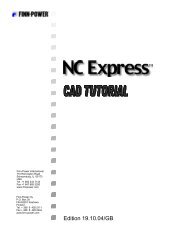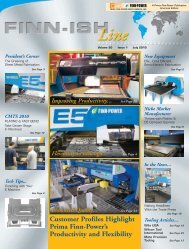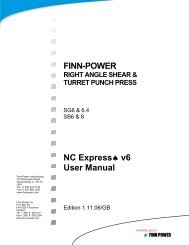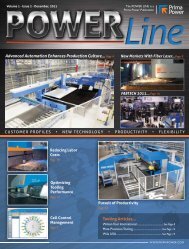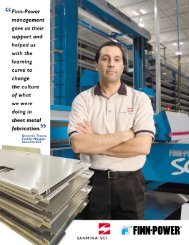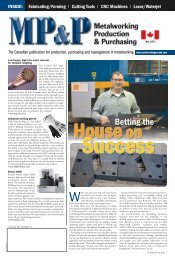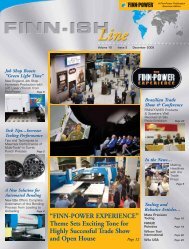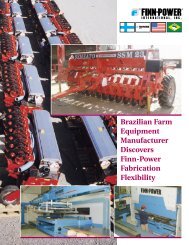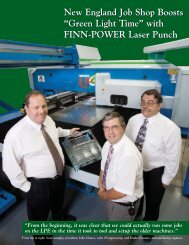Stand-Alone Punch machine user manual - Finn-Power International ...
Stand-Alone Punch machine user manual - Finn-Power International ...
Stand-Alone Punch machine user manual - Finn-Power International ...
You also want an ePaper? Increase the reach of your titles
YUMPU automatically turns print PDFs into web optimized ePapers that Google loves.
6 OPTIMIZATION<br />
Optimization is the process of combining all the tooling jobs together. It works in<br />
conjunction with nesting to bring the amount of tool changes to a minimum, thus<br />
maximizing the ability of the <strong>machine</strong> utilization. NC Express optimization will<br />
prepare a proper functioning nest for <strong>Finn</strong>-<strong>Power</strong> equipment to be processed into NC<br />
code.<br />
In a typical environment, a nested plate will utilize the Automatic Optimizer. For<br />
more complex nests, or for greater control, the use of interactive optimization can be<br />
used. The Optimizer provides automatic clamp placement prior to nesting, thus<br />
reducing repositions to a minimum. When combined with PCS clamping, it can<br />
virtually eliminate the need to reposition at all.<br />
Once parts have been nested onto a plate they are ready to be processed by the<br />
Optimizer. This step determines the most efficient path for the <strong>machine</strong> to process<br />
and produce all parts on the plate. The following section will cover items including<br />
Automatic Optimization, Interactive Optimization, and Interactive Zone creations.<br />
Automatic Optimization<br />
Presheared Parts<br />
Interactive Optimization<br />
Interactive Zones<br />
6.1 Automatic Optimization<br />
The second stage of nesting parts is the process of optimization. Even though an<br />
efficient tool path is important there are also many other <strong>machine</strong> related items that<br />
are checked during the process. Machine related items, including: clamp protection<br />
zones, <strong>machine</strong> working area, form avoidance, and proper tool usage are very<br />
important when creating error-free code for the <strong>machine</strong>. These items are all<br />
automatically checked when running the Automatic Optimizer.<br />
Within the background of NC Express, <strong>machine</strong> parameters are setup to create a<br />
complete model of the working <strong>machine</strong>. When the Automatic Optimizer is ran the<br />
items mentioned above (i.e. working area, clamp protection, etc…) are automatically<br />
checked accessing the set <strong>machine</strong> parameters. <strong>Punch</strong>es nested within the clamp<br />
protection area are seen by the optimizer and an automatic reposition of the clamps is<br />
done. Tools outside the working area of the <strong>machine</strong> (X-axis) also are given a<br />
reposition of the clamps to allow proper punching. Tool restrictions, multi-tool not<br />
capable of punching either very low or very high in the Y-axis (if placed <strong>manual</strong>ly*),<br />
will receive an error if found when optimizing. The general goal of the Automatic<br />
Optimizer is to create an automated environment when processing plates, as well as<br />
generate error free code at the <strong>machine</strong>. *Automatic Nesting will nest Multi-tools within their<br />
working area of the <strong>machine</strong>.<br />
6-97




